programming with max/msp - Virtual Sound
programming with max/msp - Virtual Sound
programming with max/msp - Virtual Sound
You also want an ePaper? Increase the reach of your titles
YUMPU automatically turns print PDFs into web optimized ePapers that Google loves.
Chapter 4P - Control signals<br />
Under the control of a square wave, the sound moves from channel to channel<br />
<strong>with</strong>out passing through intermediate positions. The sudden discontinuity,<br />
however, generates an undesirable click in the output signal. Fortunately, this can<br />
be eliminated by filtering the control signal <strong>with</strong> a lowpass filter, which smooths<br />
the sharp corners of the square wave. (See Figure 4.5 for this modification.)<br />
Fig. 4.5 Filtering an LFO<br />
In this patch, we have set a cutoff frequency of 20 Hz, which means that the<br />
control signal can’t jump from one value to the other faster than 20 times a<br />
second. Try changing the cutoff frequency for the filter to better understand<br />
how it influences the path of the sound; the lower the cutoff frequency, the<br />
smoother the transitions between channels will be.<br />
(...)<br />
other sections in this chapter:<br />
4.2 DC OFFSET<br />
4.3 CONTROL SIGNALS FOR FREQUENCY<br />
Simulating a theremin<br />
4.4 CONTROL SIGNALS FOR AMPLITUDE<br />
4.5 MODULATION OF THE DUTY CYCLE<br />
(PULSE WIDTH MODULATION)<br />
4.6 CONTROL SIGNALS FOR FILTERS<br />
4.7 OTHER GENERATORS OF CONTROL SIGNALS<br />
The modulation matrix<br />
4.8 CONTROL SIGNALS: MULTI-CHANNEL PANNING<br />
from “Electronic Music and <strong>Sound</strong> Design” Vol. 1 by Alessandro Cipriani and Maurizio Giri<br />
© ConTempoNet 2010 - All rights reserved<br />
4P<br />
495







